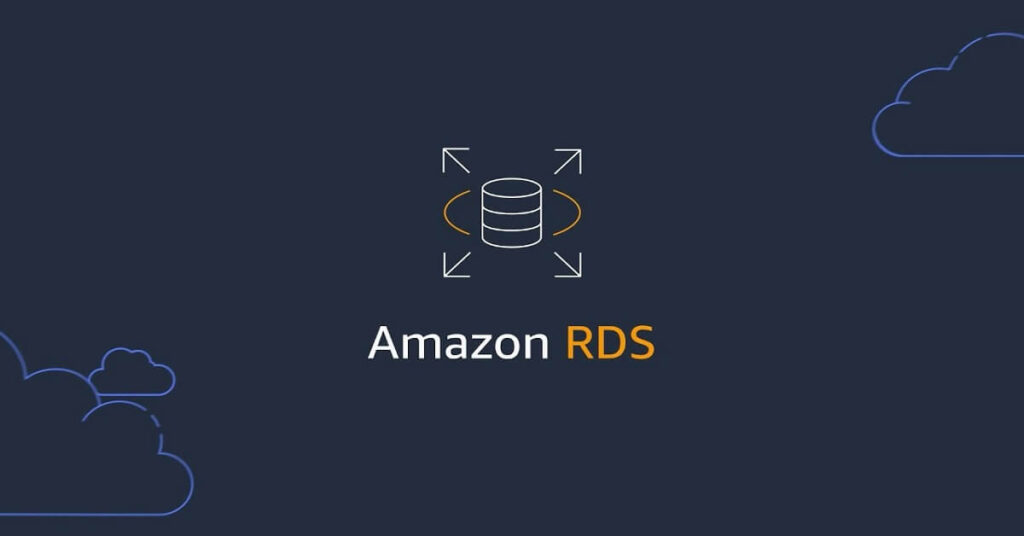Cloud computing has a database responsible for its operation and data storage.
It is especially true for businesses with increased workloads and scaling applications — managing and maintaining the databases becomes challenging and tedious.
Amazon Relational Database Service (RDS) has a better resolution to such dilemmas by providing a service that allows professionals to concentrate on their applications and leave the database management to AWS.
In this post, we’ll take a closer look at what is amazon RDS in AWS, how it works, its types, what its advantages are, and Amazon RDS best practices for you to make the most out of this service for your app.
What is Amazon RDS (Amazon Relational Database Service)?
Amazon Relational Database Service, or RDS, is an Amazon Web Services (AWS) offering designed to ease management of various relational databases in the cloud.
It allows the developers to use different types of databases such as MySQL, PostgreSQL, Oracle, SQL Server, and MariaDB for their applications and run them without having to manage the infrastructure of such databases.
RDS can automatically scale storage and compute resources. This helps optimize performance as application demands grow.
Amazon RDS is designed to make database management easier, providing a reliable solution for developers and businesses alike.
Definition and Purpose
In essence, Amazon AWS RDS is a web service that enables the user to rent a relational database while handling all the administrative tasks done on the database.
Hardware provision, software patching, backup management, and scaling is what we can call these tasks since they fall within the maintenance of the database.
Its core objective is to be as managed as possible because all the efforts are aimed at enabling the user to concentrate on the development of applications rather than managing databases.
Amazon RDS Example:
a company can quickly set up a MySQL database on RDS, benefiting from automated backups, software patching, and scaling capabilities.
This eliminates the need for manual intervention in routine maintenance, enabling developers to focus on application development.
With multi-AZ deployments, RDS offers high availability and failover support, ensuring that applications remain operational even in case of unexpected failures.
Overall, Amazon RDS provides a robust solution for businesses needing efficient database management without the overhead of traditional infrastructure.
How Amazon RDS Works?
Amazon RDS (Amazon Relational Database Service) personal database systems is designed to reduce the manual efforts required in managing the database.
Users can configure instances, manage storage, and handle backup and recovery processes without deep technical knowledge.
Amazon RDS automates routine tasks, freeing users from time-consuming administration.
It scales capacity based on demand, ensuring performance and availability. Security features include data encryption and network isolation, protecting sensitive information.
In short, Amazon RDS simplifies database management while enhancing efficiency and security.
The service enables businesses to concentrate on the development and execution of the applications without worrying about the management of the database.
Amazon Relational Database Service – AWS Database Types
Amazon RDS provides support for a multitude of the most used and proficient database technologies that include, but are not limited to, the following:
- Amazon Aurora: A relational database system that is compatible with both MySQL and PostgreSQL, engineered for extreme high speed, fault tolerance and up time.
- MySQL: A familiar open-source database system that provides a wide range of features and is very easy to work with.
- PostgreSQL: A highly efficient open-source relational database system with object-oriented features.
- MariaDB: An enhanced, drop-in replacement for MySQL.
- Oracle Database: A widely used database management system inside complex applications.
- Microsoft SQL Server: A database management system designed on a relational model and developed by Microsoft.
Each of these database engines has its own attributes enabling organizations to select the most appropriate solution for their particular case.
Why Are Relational Databases Important?
In situations where there is a need to keep structured data over a considerable period of time, protect it from any modifications and having to carry out complicated queries and operations, relational databases are indispensable.
This can be seen in various applications such as CRM, ERP, web applications, etc., which require set relationships between data entities.
The main advantages of these systems are data integrity, the presence of SQL (Structured Query Language) and effective control of transactions, which makes them suitable for use in critical applications.
Key Features of Amazon RDS
Amazon RDS (Relational Database Service) is a powerful cloud-based solution. It simplifies database management for developers and businesses alike.
With RDS, you can set up, operate, and scale a relational database with ease.
Amazon RDS includes a variety of features aimed at increasing the performance, availability, scalability and security aspects of the service:
Automated Backups
When using Amazon RDS, you do not need to take worry about creating backups for your database since it does that automatically and keeps the backups as per the backup retention that you set (between 1 and 35 days).
This ensures that in case of failure, data can be restored.
Multi-AZ Deployments
With Multi-AZ (Availability Zone) deployments, higher levels of availability and durability are achieved as a result of automatic replication of information onto a standby instance created in another Availability Zone.
This functionality prevents the database from being compromised or made unavailable due to hardware faults or external cutoffs.
Read Replicas
RDS previews a feature which permits the creation of read replicas thereby relieving read stresses and improving overall effectiveness.
It is possible to create numerous replicas and employ them for ensuring enhanced connectivity, fault tolerance or saving in case of system failures.
Scalability Options
With the help of Amazon RDS, one can increase the computing resources of his/her database, either by upgrading the instance size (CPU, memory, and storage) i.e. vertical scaling or by utilizing read replicas, which is a form of horizontal scaling.
This means that the database can grow in size without any down times in performance.
In summary, Amazon RDS offers powerful features like automated backups, easy scaling, and strong security, making it an excellent choice for managing databases.
These tools help businesses save time and reduce complexity, allowing for better focus on growth and innovation.
As you consider your database options, remember that Amazon RDS can streamline your operations and enhance performance.
Benefits of Amazon RDS
Amazon RDS, or Amazon Relational Database Service, offers a powerful solution for managing databases in the cloud.
This service simplifies setup, operation, and scaling, making it an excellent choice for businesses of all sizes.
Let’s explore Amazon RDS Benefits, including cost-efficiency, reliability, and ease of use, all of which can help your organization thrive in a competitive market.
Discover how Amazon RDS can streamline your database management and support your business goals effectively.
Time Savings on Database Management
Amazon Relational Database Service (RDS) is effective in taking care of most if not all administrative functions like backups, patch management, and updates.
This means that the operational burden of running your databases without any assistance is much lower thereby leaving time for engagement in other productive business operations.
Enhanced Availability and Reliability
Some features such as Multi-AZ deployments, automated backups and read replicas, Amazon RDS guarantees the high availability and fault tolerance of your database.
This is crucial especially for the applications that are mission-critical as there is no room for downtimes.
Cost-Effectiveness Through Pay-As-You-Go Pricing
Amazon RDS has a flexible, Pay-as-you-go billing system, and hence customers pay only for the resources they consume.
There are no upfront investments; moreover, instance sizes and attributes are modifiable to cater your requirements which is why RDS is affordable for everyone regardless of the size of the business.
Security Features (Encryption, VPC Integration)
The built-in security features provided by Amazon RDS include amongst other things encryption both at rest and in transit, Virtual Private Cloud (VPC) support, and identity and access management (IAM).
These features assist in safeguarding your information from any unwanted access as well as ensuring that the industry standards are adhered to.
In conclusion, Amazon RDS offers a range of benefits that can significantly enhance your database management process.
By choosing Amazon RDS, you empower your business to focus on growth and innovation. Consider making the switch today to experience these advantages firsthand.
Use Cases for Amazon RDS
Amazon RDS (Relational Database Service) is a powerful tool for developers and businesses alike. It simplifies database management and scaling.
But what are the best use cases for Amazon RDS?
Let’s dive into the versatile applications of Amazon RDS and how it can benefit your projects.
The versatility of Amazon RDS leads to its application across numerous industries and for various functions.
Below are some use cases:
Web Applications
As a common practice databases are often used in web applications to provide storage for storing user data, session details, transaction records and many more.
Amazon RDS has the necessary scalability and high availability characteristics to accommodate the growing traffic of a web app.
Mobile Applications
Scalability is also advantageous for mobile applications using RDS as a developer can easily store and manage data safely.
RDS can also accommodate the read-centric traffic that most mobile applications tend to generate with the help of read replicas.
Data Warehousing
Although Amazon RDS is primarily intended for transactional databases, it can also be employed in data warehousing situations on a smaller scale that require the use of relational databases.
Development and Testing Environments
Amazon RDS is well suited for the creation of multiple database instances for development and testing.
The developers may easily launch an RDS instance and test various setups and switch off instances when not in use, thus reducing expenses.
However, the sentence has been amended in a native level to accommodate smooth transitions.
Amazon RDS is a powerful tool that can benefit many types of businesses by simplifying database management.
From e-commerce websites to mobile applications, its use cases show how it can enhance performance and scalability.
By adopting Amazon RDS, companies can focus on growth without worrying about complex database tasks.
Getting Started with Amazon RDS
Whether you’re running a small application or a large enterprise system, understanding how to use Amazon RDS can help you manage your database more effectively and efficiently.
You will learn the key steps to get started with Amazon RDS, from creating your first database instance to monitoring performance and optimizing your setup.
Get ready to unlock the full potential of your database management with Amazon RDS.
Provisioning an instance on Amazon RDS is easy. Here is a simple way how to create Amazon RDS:
Step-by-Step Guide to Setting Up an RDS Instance:
- Login to AWS Console: Navigate to the RDS service.
- Choose Your Database Engine: Please indicate the database engine of your choice (e.g., MySQL, PostgreSQL, etc.)
- Instance Configuration: Select the type of instance, type of storage, and the geographical area in which you plan to deploy your RDS server.
- Set Backup and Availability Options: Set up backup retention periods, multi-AZ deployments, and other options according to your requirements.
- Create and Launch the Database: After you’ve adjusted the configurations, proceed to prepare the database instance and start the database service.
Tips for Configuration and Optimization
- Deploy high-availability architectural patterns using Multi-AZ deployments
- Turn on automated backups for better data persistence.
- Utilize Amazon CloudWatch for monitoring purposes and checking performance metrics for your instance.
- Employ read replicas to balance out read intensive operations.
Creating an Amazon RDS instance is a straightforward process that enhances your database management.
By following the key steps—selecting the right database engine, configuring your instance, and setting up security—you ensure a solid foundation for your applications.
Remember to monitor your performance and scale as needed to keep up with your growing demands.
Start your Amazon RDS journey today and unlock the power of efficient database management for your projects.
Amazon RDS Best Practices
Using Amazon RDS effectively requires understanding best practices.
Therefore, we’ll explore essential tips to optimize your Amazon RDS experience. From performance tuning to security measures, we’ll cover everything you need to know.
Let’s dive in and enhance your database management strategy.
Monitoring and Performance Tuning
It is important to consistently assess your RDS database with Amazon CloudWatch and tools that are specific to databases in order to eliminate performance hindrances.
In order to maintain the integrity of the database system, careful analysis of the executing queries, proper implementation of the indexing strategies, as well as scaling of the database instances is critical.
Backup Strategies
Develop an optimal backup policy making use of the automated backup option available within the Amazon RDS system.
This is to guarantee that in the event a database gets lost or some of its contents get corrupted, a restoration process can be conducted in a timely manner.
Security Measures
Make sure that the security aspects of your RDS instances are taken into consideration:
- Use VPC for network segregation.
- Apply encryption to any information stored as well as that which is in movement.
- Adopt AWS IAM to manage resource access and implement verification measures.
Following the best practices for Amazon RDS can make a significant difference in your database performance and security.
Regular backups, proper instance sizing, and monitoring are essential steps to ensure smooth operations.
By implementing these strategies, you will enhance reliability and reduce costs.
Conclusion
Amazon RDS is an excellent managed service that alleviates the burden of database management while providing adequate scalability, reliability and security of relational databases.
With mechanisms like automated backups, Multi-AZ deployments, read replicas, and scaling options, RDS allows business owners to invest their time and energy on the applications rather than worries on the database upkeep care.
Be it a web or mobile application development, data warehouse provisioning, or a development environment, Amazon RDS has everything required for database handling without compromising performance and expenditure.



